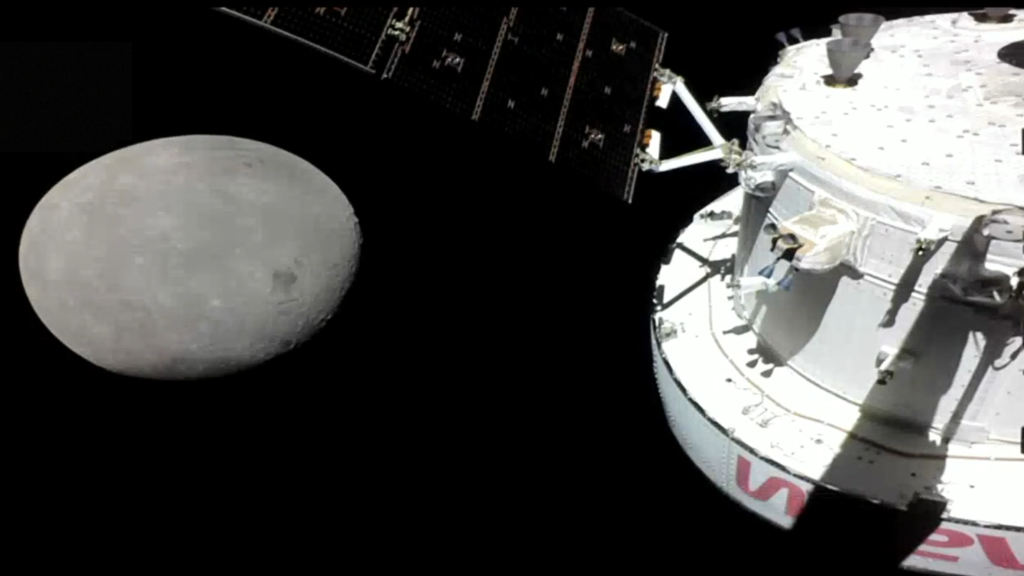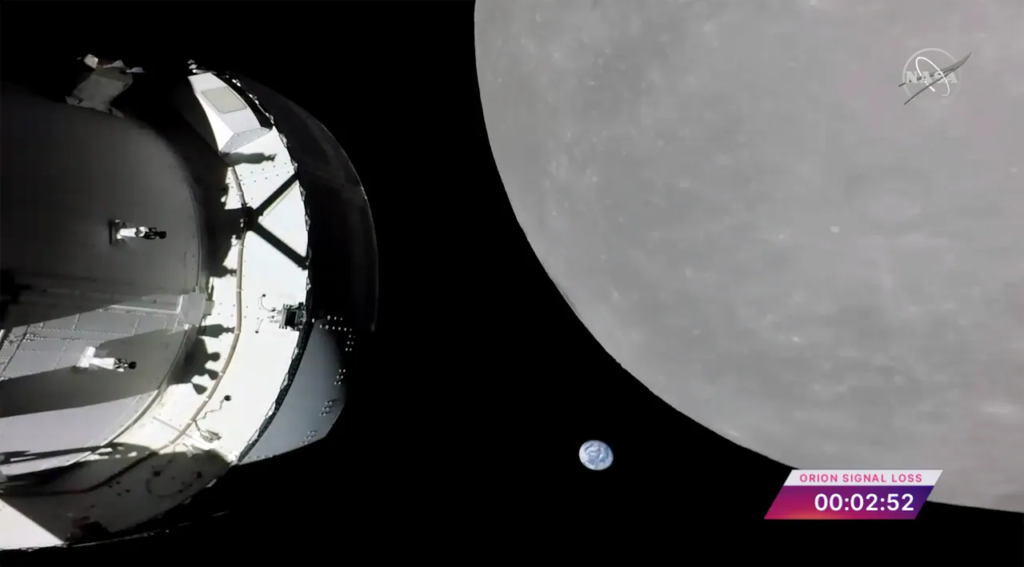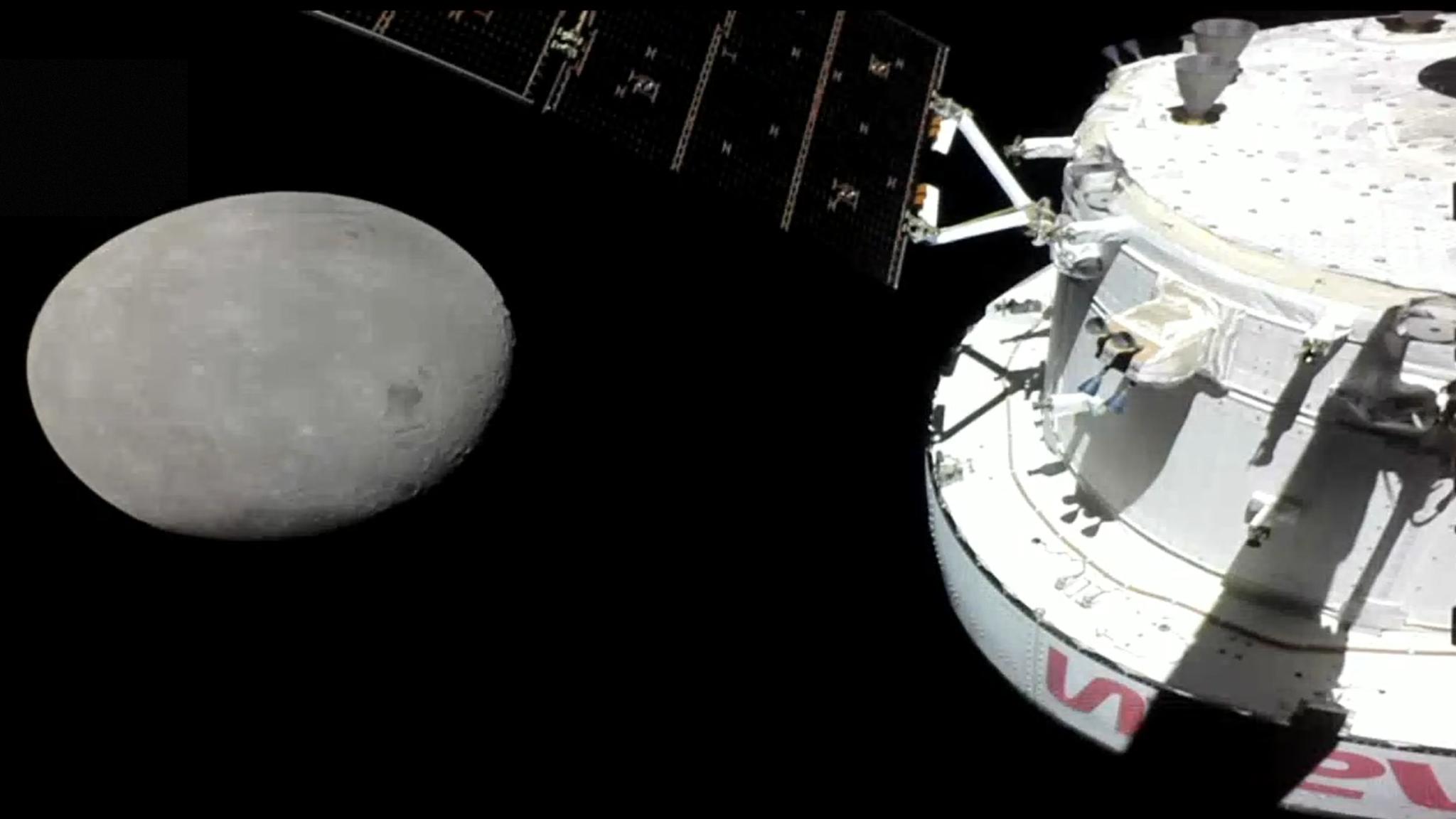
NASA’s Orion Spacecraft Has Reached The Moon
Just recently the Space Launch System lifted off for the first time ever. Now only around 5 days later, the Orion spacecraft has also completed a first with its most recent operations and pass of the Moon. Flight controllers in the White Flight Control Room at NASA’s Johnson Space Center in Houston have been busy keeping track of and ensuring everything goes according to plan.
Specifically, just earlier this morning, NASA announced that Orion had completed a successful fly by of the Moon. At its closest point, Orion was just 81 miles above the surface of the Moon, providing some incredible footage and images. While exciting, the spacecraft still has a long journey ahead of it with some additional firsts.
Not long from now, the spacecraft will perform the distant retrograde orbit insertion burn Friday, Nov. 25, using the European Service Module. The agency was also able to reacquire a signal with the spacecraft soon after its trip around the Moon. Here I will go more in-depth into this morning’s milestone, exactly what the Orion Spacecraft is doing, what to expect in the coming days, and more.
Orion’s Successful Fly-by

Just one hour ago, Jim Free tweeted saying, “Fly-by complete! @NASA_Orion completed its closest fly-by of the Moon this morning, 81 miles above the lunar surface, traveling 5,102 mph. Before the fly-by, we conducted an outbound powered fly-by burn, increasing speed at a rate of more than 580 mph. In this case, Orion re-acquired signal with NASA’s Deep Space Network, at 7:59 a.m. EST after successfully performing the outbound powered flyby burn at 7:44 a.m. EST with a firing of the orbital maneuvering system engine for 2 minutes and 30 seconds to accelerate the spacecraft at a rate of more than 580 mph. At the time of the burn, Orion was 328 miles above the Moon, traveling at 5,023 mph. Shortly after the burn, Orion passed 81 miles above the Moon, traveling at 5,102 mph. At the time of the lunar flyby, Orion was more than 230,000 miles from Earth.
The outbound powered flyby burn is the first of two maneuvers required to enter the distant retrograde orbit around the Moon. The spacecraft will perform the distant retrograde orbit insertion burn Friday, Nov. 25, using the European Service Module. Orion will remain in this orbit for about a week to test spacecraft systems. The distant retrograde will take Orion 40,000 miles past the Moon before it returns to Earth. Orion’s greatest distance from the Earth will be Monday, Nov. 28 at 3:05 p.m. CST at more than 268,500 miles. Orion’s greatest distance from the Moon will be on Friday, Nov. 25 at 3:53 p.m. CST at more than 57,250 miles.
The Deep Space Network, managed by NASA’s Jet Propulsion Laboratory in Southern California, handles communications for Artemis I beyond low-Earth orbit. This includes the mission’s trajectory corrections, powered flyby burns, and insertion into and departure from distant retrograde orbit, while the Near Space Network provides supplemental navigation data with assistance from the Near Space Network’s tracking and data relay satellite constellation.
While the mission has been an overall success so far, it has not been without a few complications. Mission managers currently have two active anomaly resolution teams. Anomaly resolution teams are a standard part of managing the mission by pulling together a team of technical experts to focus on a specific issue by examining data to understand the implications in a particular system. Activating a separate team for this work enables engineers and flight controllers to continue focusing on commanding and monitoring the spacecraft and assessing the progress of the flight test.
One team is currently looking at the star tracker system to understand a number of faults in the random access memory, which have been successfully recovered with power cycles. A second team is analyzing a few instances in which one of eight units located in the service module that provides solar array power to the crew module, called a power conditioning and distribution unit umbilical latching current limiter, opened without a command. The umbilical was successfully commanded closed each time and there was no loss of power flowing to avionics on the spacecraft. Both systems are currently functioning as required, and there are no mission impacts related to these efforts. Analyzing the data for these systems and understanding their behavior during an active flight test while the hardware is in the deep space environment will improve mission operations on Artemis I and future missions.
What’s Next?

Now that we know more about Orion’s journey so far and the Moon fly by this morning, we can take a closer look at what to expect in the coming days and weeks prior to the splashdown. Currently, the Orion spacecraft will stay in its orbit for approximately six days to collect data and allow mission controllers to assess the performance of the spacecraft. During this period, Orion will travel in a direction around the Moon retrograde from the direction the Moon travels around Earth.
As for its return trip to Earth, Orion will do another close flyby that takes the spacecraft within about 60 miles of the Moon’s surface, the spacecraft will use another precisely timed engine firing of the European-provided service module in conjunction with the Moon’s gravity to accelerate back toward Earth. This maneuver will set the spacecraft on its trajectory back toward Earth to enter our planet’s atmosphere traveling at 25,000 mph (11 kilometers per second), producing temperatures of approximately 5,000 degrees Fahrenheit (2,760 degrees Celsius) – faster and hotter than Orion experienced during its 2014 flight test.
After about four to six weeks and a total distance traveled exceeding 1.3 million miles, the mission will end with a test of Orion’s capability to return safely to the Earth as the spacecraft makes a precision landing within eyesight of the recovery ship off the coast of Baja, California. Following splashdown, Orion will remain powered for a period of time as divers from the U.S. Navy and operations teams from NASA’s Exploration Ground Systems approach in small boats from the waiting recovery ship. The divers will briefly inspect the spacecraft for hazards and hook up tending and tow lines, and then engineers will tow the capsule into the well-deck of the recovery ship to bring the spacecraft home.
We can also take a look at some of the additional progress the spacecraft has made during the last few days. For example, during flight day four, flight controllers moved each solar array to a different position to test the strength of the WiFi signal with the arrays in different configurations. The Integrated Communications Officer, or INCO, tested the WiFi transfer rate between the camera on the tip of the solar array panels and the camera controller. The goal was to determine the best position to most efficiently transfer imagery files. Teams learned that having multiple cameras on at once can impact the WiFi data rate, and therefore, future solar array wing file transfer activities will be accomplished from one solar array wing at a time to optimize transfer time.
The Emergency, Environmental, and Consumables Manager, or EECOM, tested Orion’s radiator system. Two radiator loops on the spacecraft’s European Service Module help expel excess heat generated by different systems throughout the flight. Flight controllers are testing sensors that maintain the coolant flow in the radiator loops, switching between different modes of operation and monitoring performance. During speed mode, the coolant pumps operate at a constant rate. This is the primary mode used during Artemis I. Flow control mode adjusts the pump speed as needed to maintain a constant flow through the system. The flight test objective is to monitor system performance and the accuracy of flow sensors to characterize the stability of this mode of operation. Each loop is monitored in flow control mode for 72 hours to provide sufficient data for use on future missions.
Not to mention, as part of planned testing throughout the mission, the guidance, navigation, and control officer, also known as GNC, performed the first of several tests of the star trackers that support Orion’s navigation system. Star trackers are a navigation tool that measure the positions of stars to help the spacecraft determine its orientation. In previous flight days, engineers evaluated initial data to understand star tracker readings correlated to thruster firings. Engineers hope to characterize the alignment between the star trackers that are part of the guidance, navigation, and control system and the Orion inertial measurements units, by exposing different areas of the spacecraft to the Sun and activating the star trackers in different thermal states. Altogether the mission has been quite successful so far with only a few small complications that NASA is working on.
Conclusion
The Orion Spacecraft that was launched only days ago has successfully reached the Moon. Just this morning the spacecraft flew 81 miles above the surface and will soon head back to Earth. Once complete, the next step will be putting humans on the spacecraft and launching them apart of Artemis II. We will have to wait and see how it progresses and the impact it has on the space industry.
